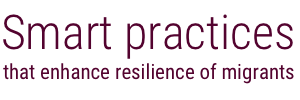A tool to monitor displacement that provides timely, reliable data and information for response planning.
IOM’s Displacement Tracking Matrix (DTM) captures, processes and disseminates timely information on human mobility flows in times of crisis. The system captures details on the nature of and reasons for displacement; information on displacement sites and movement dynamics; key vulnerabilities; details on sectoral needs and assistance; spatial data; and demographic information.
DTM has four phases of implementation: planning, data collection, processing and analysis, and reporting. To deploy DTM, IOM maintains a roster of experts who support data collection remotely and in-country. In natural disaster contexts, DTM aims for a rapid assessment within the first 72 hours to collect the most essential data required for operational planning. This is followed by more detailed assessments to collect comprehensive information on the evolving needs and situation of displaced populations. Regular updates are conducted to monitor existing locations or trails, and report changes in the situation and identified needs. In the long term, DTM attempts to integrate with other supporting systems and with development actors to contribute to recovery and rehabilitation efforts.
DTM Information outputs include raw data, narrative reports, site profiles, thematic maps and a web geo portal. DTM products are publicly available to feed directly into humanitarian response planning and operational adjustments. Since 2004, IOM has used the DTM in over 40 countries, ranging from Iraq, to Nigeria, South Sudan, the Democratic Republic of Congo, Colombia, Haiti and Nepal.
- Ensuring operational follow-up on the needs highlighted by DTM can be difficult, particularly in resource or security-constrained contexts, where there is a sparse presence of actors on the ground.
- Comparability of data at global level can be useful to inform future responses. This requires definition of core standards in data collection exercises. IOM has therefore developed a DTM data dictionary to allow information from different countries to feed into a central data warehouse at global level.
- Mobile data collection systems can make data handling more effective and IOM has successfully incorporated mobile data collection into several recent DTM deployments.
- Partnerships with private-sector partners have proven useful to enhance data analysis and visualization systems.

